Dear Zazie,
Here is today’s Lovers’ Chronicle from Mac Tag to his muse. This is one of our favorite days in TLC. Beauty and sorrow, our two favorite topics, were never done better than by the trio of today’s birthday boys.
Rhett
The Lovers’ Chronicle
Dear Muse,
that you understand
certainly one reason
there are many
you, who have read
’em all, know ’em
the dark pull surfaces
know and again and
this day serves as reminder
to channel that impulse
through verse or color
to express the possibilities
in every scene, over and over
© copyright 2022 mac tag/cowboycoleridge all rights reserved
no more fallin’
tears
nor long ache
the worst pain
not to understand
without
what have we done,
standin’ here
what will we do
with what is left
we must let this vision ride with luck
on the back of verse that moves
touched with the passion
and colors that ignite
nothin’ else matters
© copyright 2021 mac tag/cowboycoleridge all rights reserved
© copyright 2020 mac tag/cowboy coleridge all rights reserved
her paintin’s were strikin’
the blackest i ever saw
but life gave her that
she never asked for it
she would talk of tears
that would not fall
and the long ache
she would paint
the darkness
and i would write
tryin’ to keep up,
to understand
her full heart
then
done, standin’ there
tell me what is left
because without you
rien ne suis
rien ne puis
© copyright 2019 mac tag/cowboy coleridge all rights reserved
look forward to this day
to seek the possibilities
of black in everything
in movies, in books
in art, in verse
in bars, in the eyes
of the ones encountered
who knew it as well or better
what else matters
these stories
these scenes
what they know
those who have been
© copyright 2018 mac tag/cowboycoleridge all rights reserved
wish we were in Madrid
at the Museo del Prado
to see them again
the pain, the fear
the beauty
later, we would
drink absinthe
and read Verlaine
and offer ourselves
to each other
to be consumed
© copyright 2016 Mac tag/cowboy coleridge all rights reserved
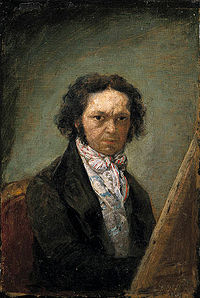
Self-portrait, c. 1796-97. Museo del Prado
Today is the birthday of Francisco Goya (Francisco José de Goya y Lucientes; Fuendetodos, Aragón, Spain 30 March 1746 – 16 April 1828 Bordeaux); romantic painter and printmaker. In my opinion, the most important Spanish artist of late 18th and early 19th centuries. Goya is often referred to as both the last of the Old Masters and the first of the moderns. Far and away, my favorite Goya paintings are his so called Pinturas negras (Black Paintings). They are a group of fourteen paintings from the later years of his life, likely between 1819 and 1823. The paintings portray intense, haunting themes, reflective of both his fear of insanity and his bleak outlook on humanity. In 1819, at the age of 72, Goya moved into a two-story house outside Madrid that was called Quinta del Sordo (Deaf Man’s Villa). All of the paintings were executed in oil directly onto the plaster walls of the house. Goya apparently, did not intend for the paintings to be exhibited, nor did not write of them. It was not until around 1874, about 50 years after his death, that they were taken down and transferred to a canvas support. The effects of time on the murals, coupled with the inevitable damage caused by the delicate operation of mounting the crumbling plaster on canvas, meant that most of the murals suffered extensive damage and loss of paint. Today they are on permanent display at the Museo del Prado, Madrid. Goya did not give titles to the paintings, or if he did, he never revealed them. Most names used for them are designations employed by art historians. Initially, they were catalogued in 1828 by Goya’s friend, Antonio Brugada. Pinturas negras have inspired my verse, time and again. I have a long, unfinished, epic poem about them. Here they are:
Images of the Pinturas negras
|
|
|
The Song of the Day is Peter Gabriel Fourteen Black Paintings. we do not own the rights to this song. all rights belong to rightful owner.
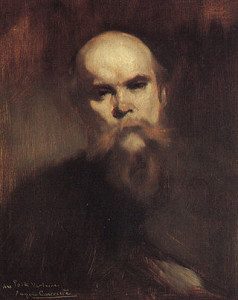
Portrait by Eugène Carrière 1890
Today is the birthday of Paul Verlaine (Paul-Marie Verlaine, Metz 30 March 1844 – 8 January 1896 Paris); poet associated with the Symbolist movement. In my opinion, he is one of the greatest representatives of the fin de siècle in international and French poetry. Here are a few of my favorite Verlaine verses:
Il pleure dans mon cœur
Comme il pleut sur la ville.
Quelle est cette langueur
Qui pénètre mon cœur?
- Falling tears in my heart,
Falling rain on the town.
Why this long ache,
A knife in my heart. - “Il pleur dans mon cœur” line 1, from Romances sans paroles (1874); Sorrell p. 69
- C’est bien la pire peine
De ne savoir pourquoi
Sans amour et sans haine
Mon cœur a tant de peine!- By far the worst pain
Is not to understand
Why without love or hate
My heart’s full of pain. - “Il pleur dans mon cœur” line 13, from Romances sans paroles (1874); Sorrell p. 71
- By far the worst pain
Qu’as-tu fait, ô toi que voilà
Pleurant sans cesse,
Dis, qu’as-tu fait, toi que voilà
De ta jeunesse?
- What have you done, you standing there
In floods of tears?
Tell me what you have done
With your young life? - “Le ciel est, par-dessus le toit”, line 13, from Sagesse (1880); Sorrell p. 111
Que ton vers soit la bonne aventure
Éparse au vent crispé du matin
Qui va fleurant la menthe et le thym…
Et tout le reste est littérature.
- You must let your poems ride their luck
On the back of the sharp morning air
Touched with the fragrance of mint and thyme…
And everything else is literature. - Line 33, Sorrell p. 125
Aime-moi
car sans toi
rien ne suis
rien ne puis
| Vincent van Gogh | |
|---|---|
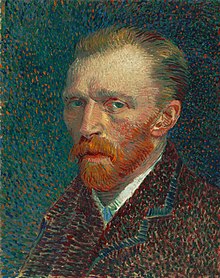
Self-Portrait, 1887, Art Institute of Chicago
|
|
Today is the birthday of Vincent Willem van Gogh (Zundert, Netherlands 30 March 1853 – 29 July 1890 Auvers-sur-Oise, France); Post-Impressionist painter who is among the most famous and influential figures in the history of Western art. In just over a decade he created about 2,100 artworks, including around 860 oil paintings, most of them in the last two years of his life in France. They include landscapes, still lifes, portraits and self-portraits, and are characterised by bold colours and dramatic, impulsive and expressive brushwork that contributed to the foundations of modern art. His suicide at 37 followed years of mental illness and poverty.
Van Gogh suffered from psychotic episodes and delusions and though he worried about his mental stability, he often neglected his physical health, did not eat properly and drank heavily. His friendship with Paul Gauguin ended after a confrontation with a razor, when in a rage, he severed part of his own left ear. He spent time in psychiatric hospitals, including a period at Saint-Rémy. After he discharged himself and moved to the Auberge Ravoux in Auvers-sur-Oise near Paris, he came under the care of the homeopathic doctor Paul Gachet. His depression continued and on 27 July 1890, Van Gogh shot himself in the chest with a revolver. He died from his injuries two days later.
Van Gogh was unsuccessful during his lifetime, and was considered a madman and a failure. He became famous after his suicide, and exists in the public imagination as the quintessential misunderstood genius, the artist “where discourses on madness and creativity converge”. His reputation began to grow in the early 20th century as elements of his painting style came to be incorporated by the Fauves and German Expressionists. He attained widespread critical, commercial and popular success over the ensuing decades, and is remembered as an important but tragic painter, whose troubled personality typifies the romantic ideal of the tortured artist.
Gallery
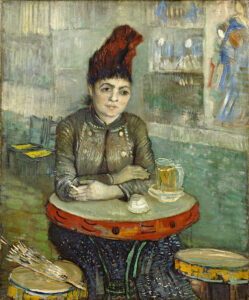
Donna al Cafè Le Tambourin
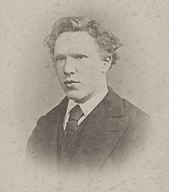


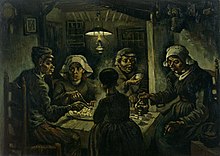
-

Worn Out, pencil on watercolour paper, 1882. Van Gogh Museum, Amsterdam [90]
-
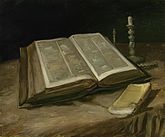
Still Life with Open Bible, Extinguished Candle and Novel also Still Life with Bible, 1885. Van Gogh Museum, Amsterdam
-
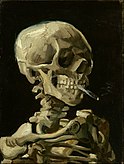
Skull of a Skeleton with Burning Cigarette, 1885–86. Van Gogh Museum, Amsterdam
-
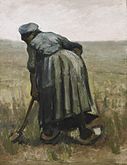
Peasant Woman Digging, or Woman with a Spade, Seen from Behind, 1885. Art Gallery of Ontario, Toronto
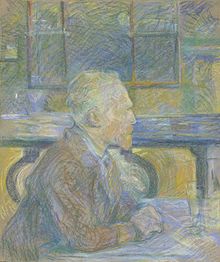
-

Courtesan (after Eisen), 1887. Van Gogh Museum, Amsterdam
-
Portrait of Père Tanguy, 1887. Musée Rodin, Paris
-
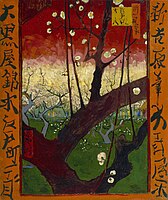
Flowering Plum Orchard (after Hiroshige), 1887. Van Gogh Museum, Amsterdam
-

Still Life with Glass of Absinthe and a Carafe, 1887. Van Gogh Museum, Amsterdam

-
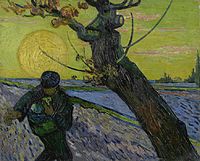
The Sower with Setting Sun, 1888. Van Gogh Museum, Amsterdam
-

Fishing Boats on the Beach at Saintes-Maries, June 1888. Van Gogh Museum, Amsterdam
-
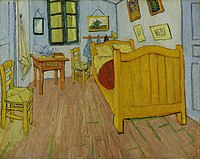
Bedroom in Arles, 1888. Van Gogh Museum, Amsterdam
-
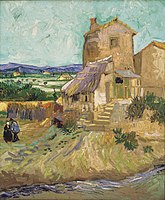
The Old Mill, 1888. Albright–Knox Art Gallery, Buffalo, New York

-
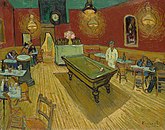
The Night Café, 1888. Yale University Art Gallery, New Haven, Connecticut
-

The Red Vineyard, November 1888. Pushkin Museum, Moscow. Sold to Anna Boch, 1890
-

Van Gogh’s Chair, 1888. National Gallery, London
-
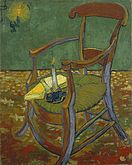
Paul Gauguin’s Armchair, 1888. Van Gogh Museum, Amsterdam
-

Self-portrait with Bandaged Ear and Pipe, 1889, private collection
-
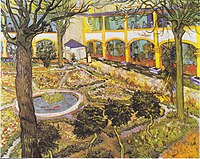
The Courtyard of the Hospital at Arles, 1889, Oskar Reinhart Collection “Am Römerholz”, Winterthur, Switzerland
-

Self-portrait with Bandaged Ear, 1889, Courtauld Institute of Art, London
-

Ward in the Hospital in Arles, 1889, Oskar Reinhart Collection “Am Römerholz”, Winterthur, Switzerland

-

The Round of the Prisoners (after Doré), 1890. Pushkin Museum, Moscow
-

The Sower, (after Millet), 1888. Kröller-Müller Museum, Otterlo
-
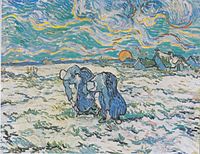
Two Peasant Women Digging in a Snow-Covered Field at Sunset, (after Millet), 1890. Foundation E.G. Bührle Collection, Zurich, Switzerland
-

Sorrowing Old Man (‘At Eternity’s Gate’), 1890. Kröller-Müller Museum, Otterlo

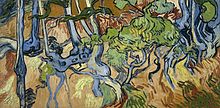


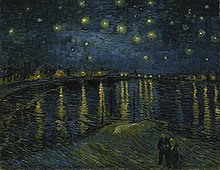
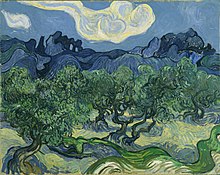


-

Portrait of Artist’s Mother, October 1888, Norton Simon Museum of Art, Pasadena, California
-
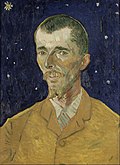
Eugène Boch, (The Poet Against a Starry Sky), 1888, Musée d’Orsay, Paris
-

Portrait of the Postman Joseph Roulin (1841–1903) early August 1888, Museum of Fine Arts, Boston
-
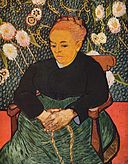
La Berceuse (Augustine Roulin) 1889, Museum of Fine Arts, Boston

-

Self-Portrait with Grey Felt Hat, Winter 1887–88. Van Gogh Museum, Amsterdam
-

Self-Portrait with Straw Hat, Paris, Winter 1887–88. Metropolitan Museum of Art, New York
-

Self-Portrait, 1889. National Gallery of Art, Washington, D.C. His Saint-Rémy self-portraits show his side with the unmutilated ear, as he saw himself in the mirror
-

Self-Portrait Without Beard, c. September 1889. This painting may have been Van Gogh’s last self-portrait. He gave it to his mother as a birthday gift

-
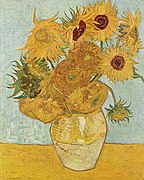
Still Life: Vase with Twelve Sunflowers, August 1888. Neue Pinakothek, Munich
-

Irises, 1889. J. Paul Getty Museum, Los Angeles
-

Almond Blossom, 1890. Van Gogh Museum, Amsterdam
-

Still Life: Vase with Irises Against a Yellow Background, May 1890, Van Gogh Museum, Amsterdam
-

Still Life: Pink Roses in a Vase, May 1890, Metropolitan Museum of Art, New York
-

Cypresses in Starry Night, a reed pen drawing executed by Van Gogh after the painting in 1889
-
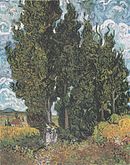
Cypresses and Two Women, 1890. Kröller-Müller Museum, Otterlo, Netherlands
-

Wheat Field with Cypresses, 1889. Metropolitan Museum of Art, New York
-
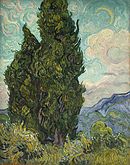
Cypresses, 1889. Metropolitan Museum of Art, New York
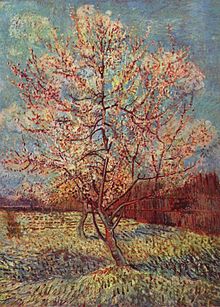
-

The Pink Orchard also Orchard with Blossoming Apricot Trees, March 1888. Van Gogh Museum, Amsterdam
-

Orchard in Blossom, Bordered by Cypresses, April, 1888. Kröller-Müller Museum, Otterlo, Netherlands
-

View of Arles, Flowering Orchards, 1889. Neue Pinakothek, Munich

-

Enclosed Wheat Field with Rising Sun, May 1889, Kröller-Müller Museum, Otterlo, Netherlands
-

Rain or Enclosed Wheat Field in the Rain, November 1889, Philadelphia Museum of Art, Philadelphia
-

Wheat Fields (Van Gogh series), early June 1889. Kröller-Müller Museum, Otterlo
-

Wheat Field at Auvers with White House, June 1890, The Phillips Collection, Washington D.C.

– Vincent Van Gogh
Mac Tag


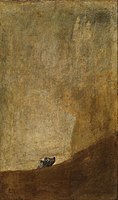

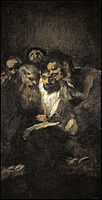
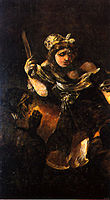
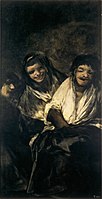









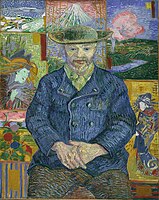
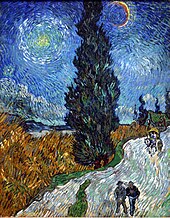
No Comments on "The Lovers’ Chronicle 30 March – Pinturas negras – art by Francisco Goya & Vincent Van Gogh – verse by Verlaine"